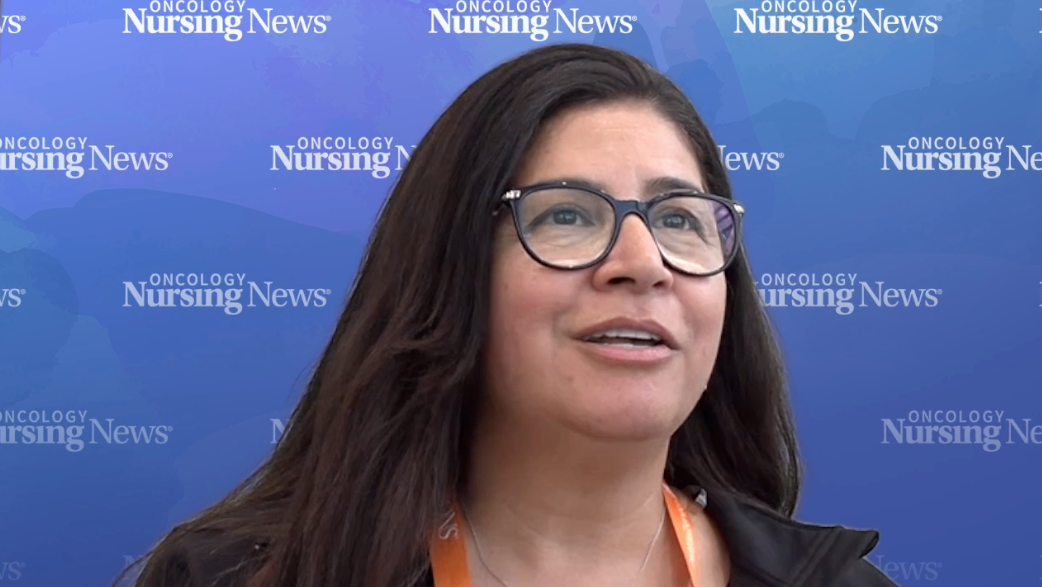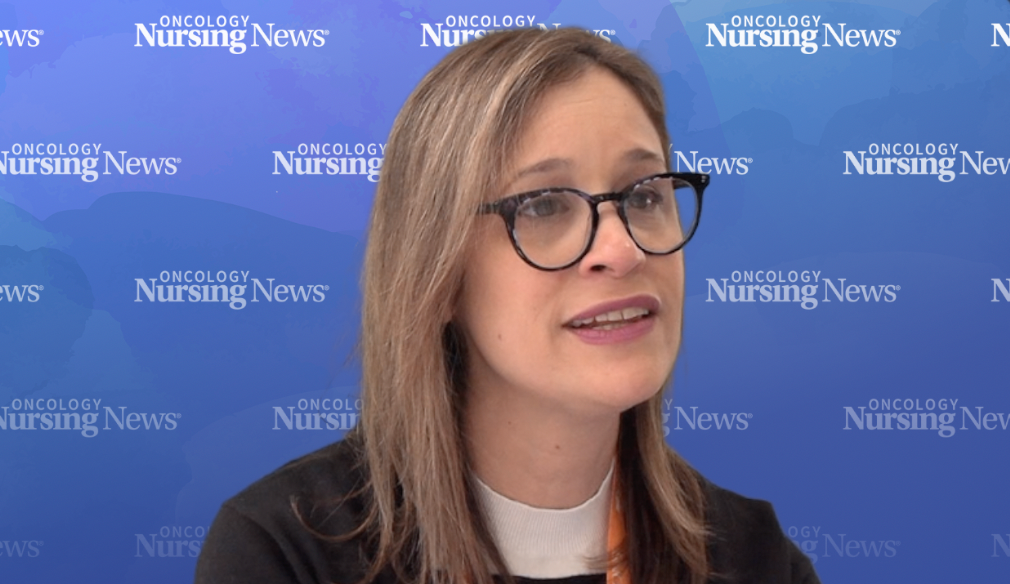Opening the Conversation Around Palliative Care for Patients With Cancer
An expert discussed a screening tool that she and her colleagues used to connect patients with cancer to palliative care services in a more effective way.
Opening the Conversation Around Palliative Care for Patients With Cancer

A palliative care screening tool may help oncology nurses effectively connect patients with cancer to a consultation to receive services that sometimes have misconceptions tied around them, according to findings from a study published in the Clinical Journal of Oncology Nursing.
Kaitlin Whyman, DNP, AGPC, and her colleagues conducted a study assessing a validated palliative care screening tool for adult patients with solid tumor malignancies. Utilizing the screening tool on admission resulted in significant increases in palliative care consultation rates and decreases in average patient lengths of stay and readmission rates.
The palliative care screening tool was an 11-item questionnaire that was adapted from the National Comprehensive Cancer Network’s Palliative Care Clinical Practice Guidelines in Oncology and collected information around the 5 clinical dimensions related to unmet palliative care needs: performance status, extent of disease, comorbidities, prognosis, and palliative care-specific problems. With regard to palliative care-specific problems, these included patient/family concerns regarding decision making, moderate to severe distress, uncontrolled symptoms, prolonged length of stay, patient or family requests for a palliative care consultation, and needs of the team for assistance with decision-making.
Patients were screened upon admission, and scores of 5 or greater indicated that a discussion around palliative care was needed.
In the postintervention cohort, 76% of patients who were screened were indicative of unmet palliative care needs. Before the intervention, 23% of patients received a consultation for palliative care. This increased by 36% after the intervention, with 59% of patients receiving a consultation for palliative care. The researchers noted a clinically meaningful and statistically significant link between screening for unmet palliative care needs and patients who received a consultation (chi-square [1, N = 134] = 17.2; P < .001).
“What [these findings] reinforced was that nurses want to be involved in these conversations,” Whyman, an acute care nurse practitioner at University of Maryland Medical Center in Baltimore, said in an interview with Oncology Nursing News. “And nurses have, for a long time, wanted to be involved in these conversations, but often feel that when they try to present this information to providers, it came come off as ambiguous. … And so being able to give these nurses a tool that has been tested and validated and says, if this score happens, then these patients have unmet palliative care needs. It allowed them to really bring to the providers this concrete, less-subjective piece of evidence, which then opens the conversation, regarding connecting patients to palliative care, to happen a little bit more.”
Throughout this study, there was no statistically significant decrease in average length of stay (P = .558) and readmission rates (P = .748) in the groups of patients who did and did not undergo the intervention. “This can be interpreted to mean that receiving a [palliative care] screening on admission did not significantly change patients’ [lengths of stay] or readmission rates,” the researchers wrote.
The preintervention cohort had a mean length of stay of 6.8 days (standard deviation = 6.5) compared with 6.1 days (standard deviation = 6.5) for the postintervention cohort, representing a 0.7-day decrease between both groups’ mean lengths of stay. In addition, the readmission rate for the preintervention cohort was 43% vs 39% for the postintervention cohort, indicating a 4% decrease.
Even though this intervention did not decrease a patient’s length of stay, Whyman noted that identifying which patients require palliative care can help improve their care in the long term.
“Connecting patients to palliative care early doesn’t mean that we think patients are close to death,” she said. “It’s a really common misconception, but we do think that patients have these unmet nausea [and] pain needs, and that by meeting those earlier and having these services keyed in, it prevents them from being in the hospital as long or coming back to the hospital with recurrent pain and other common complications of treatment. It allows them to take more of their treatment outpatient and time at home as opposed to coming back into the hospital for very similar issues. Once you connect [the patient to] inpatient [services], it’s very easy to continue that connection [with] outpatient [services]. So when they see their providers [in an] outpatient [setting], they can see their palliative care provider, adjust their pain meds, and avoid those unwanted admissions.”
Whyman explained that this common misconception around palliative care was one of the main drivers behind this study.
“My career has been [in] oncology, and something that I noticed very early on was this misunderstanding surrounding palliative care,” Whyman said. “I came out of nursing school, and I feel like we were effectively taught that palliative care was this large umbrella. Hospice was one rung and symptom management was another. And being someone who wanted to work in oncology, this sounds great. All patients should be connected to palliative care in oncology. I realized that was not the case, often due to not being connected to the services early enough on. Further, when patients were connected, it was later in diagnosis or close to the end of life, meaning they were not utilizing all the benefits palliative care has to offer.”
She said that another part of the reason why patients were not receiving palliative care in oncology may be related to misconceptions around palliative care.
“There are still a lot of providers — just because of how medicine has been taught over the years, especially in the past—that some providers still kind of think those two terms [palliative care and hospice] are synonymous, creating some resistance to engaging the specialties services” she added.
In addition to helping patients with cancer access palliative care, Whyman believed that this approach can also help oncology nurses boost morale.
“To be an oncology nurse, you really … understand that your job is twofold. It's taking care of people throughout this disease continuum.You want to help given them quality of life throughout treatment, but that part of your responsibility may also be helping lead people out of this world, and that you can feel good about that. That doesn't mean it's been a bad day or a failure; you can feel OK about knowing that you've allowed someone to leave this world comfortably, on their own terms, and with closure. When that's not happening, and palliative care is getting called in late for end-of-life management, or even for just general symptom management, it can be very distressing to staff who [think], … we've been talking to you for months about this patient and their symptoms or that we were worried that their journey may be shifting to end-of-life and we wanted them to be connected [to palliative care] earlier.”
Reference
Whyman K, Thompson K, Turner MM. Impact of a Nurse-Led Palliative Care Screening Tool on Medical Oncology Units. Clin J Oncol Nurs. 2024;28(1):26-31. doi:10.1188/24.CJON.26-31
Nursing Perspectives on Managing Toxicities With ADCs in Metastatic Gastric and Breast Cancers
September 1st 2022In this episode of "The Vitals," Sarah Donahue, MPH, NP, AOCNP; Jamie Carroll, APRN, CNP, MSN; Theresa Wicklin Gillespie, PhD, MA, RN, FAAN; and Elizabeth Prechtel-Dunphy, DNP, RN, ANP-BC, AOCN, exchange clinical pearls for treating patients receiving antibody-drug conjugates.
Workflow, Educational Tools Improve Use of Silicone Film to Prevent Radiation Dermatitis
April 25th 2024Tools to educate oncology nurses and patients on the use of Mepitel film to prevent radiation dermatitis has improved the workflow around its introduction to patients with breast cancer, as well as its application and maintenance.




